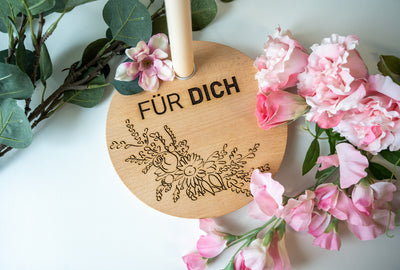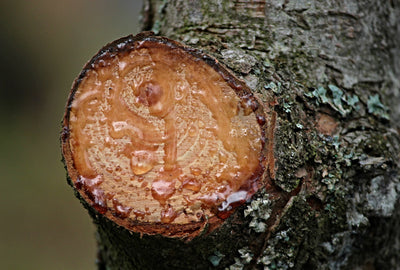The term "tropical wood" can be found in the descriptions of designer furniture, decorations, veneer and craft supplies. But what actually is tropical wood? Is it an exotic, darker type of wood from the rainforest or does the sonorous word promise more than it delivers? Mr Beam answers the most important questions about tropical timber.
This is generally understood as tropical wood
Surely you have already bought or thought about buying a product that had a label that said "tropical wood" . As a rule, we first think of the vast rainforests of the Amazon or Congo, which are being decimated by illegal clear-cutting, but also of colonial furniture, reddish wood, robust workmanship and inlays.
This picture is above all a historical one. In fact, many lavish chests of drawers, bedsteads, cupboards and desks used to be made of a hardwood like mahogany, making it particularly heavy but also durable. This wood was then often equated with the label "tropical wood" .
Definition of tropical wood according to ITTA 2006
The International Tropical Timber Agreement of 2006/2011, the revision of the 1994 regulation, defines the term in Chapter 2 Paragraph 1 as follows: "Tropical timber means tropical timber for industrial use that is grown in states between the Tropic of Cancer and Capricorn or grow. The term is used for logs, lumber, veneers and plywood."
The agreement regulates the permissibility of cultivation, felling, management and sale of these types of wood. The tropics of Cancer and Capricorn cover an area from southern Algeria to Lesotho, or from southern USA to southern Peru.
Tropical woods are found in many products. While this makes sense for furniture, flooring, and musical instruments, checking the label can prevent you from buying pencils, paper, wood briquettes, or charcoal made from tropical wood. Tropical woods are often hidden behind terms such as "hardwood", "precious wood", "real wood" or "plantation wood".
These trees are often sold as tropical timber

One of the most popular tropical woods is mahogany. It convinces with its hard, unyielding structure, red-brown colouring and is often used for wood decorations. Real mahogany wood is very expensive and requires a special permit to be imported into Germany. A large species mahogany tree takes 25 years to reach a few meters in height and can grow up to 60 meters tall.
However , acacia, eucalyptus, teak, heat-tolerant pine, palisander, ipé or wenge are also sold as tropical woods. Not all of these types of wood originally come from the tropics. You should only buy eucalyptus from its native Australia or from certified European growing areas. It regularly promotes large forest fires in the tropics and does not offer any advantages to local animals and plants. It is not edible and repels symbiotic plants.
Does tropical wood come from the rainforest?

No, most tropical woods do not come from a natural rainforest, but from an ecologically sensible managed forest located in the tropics. Unfortunately, cutting down ancient, huge rainforest trees is still part of everyday life, for example in illegal camps in Brazil. As a rule, however, the clear-cutting takes place there in order to create space for illegal plantations or the mining of ores. The wood is illegally sold or burned, but it is not exported and is therefore not used for your furniture.
A well-managed tropical forest offers benefits to both humans and animals. It filters pollutants from the air, binds CO₂, offers shelter and protection from rain and heat. In contrast to native trees such as Robinia or Asian export hits such as bamboo, tropical wood species often have to grow for many decades before they can be harvested, whereby "harvest" in this case means the felling of the tree. However, if the wood label indicates "plantation wood", it is a monoculture that is environmentally questionable.
Properties of tropical wood species
Almost all types of wood from the tropics have one thing in common: they are particularly robust. With proper care and sealing, a building made of tropical wood could survive for many decades without being damaged, but it would be completely uneconomical. That's why we prefer to use local wood species such as pine, oak or larch for frame wood and panelling in Europe.
However, tropical wood is perfect for handicrafts. Not only does it look beautiful, but it's also less likely to break due to editing. One disadvantage is that you usually have to use technical equipment to process tropical woods. It is difficult to cut, carve or engrave a piece of hardwood by hand.
In crossword puzzles, a "tropical wood with an X letter" is often asked. You have the following answer options.
Tropical wood with ...
... 4 letters: teak
... 5 letters: Awong, Balsa, Limba, Makor, Okume, Ebony
... 6 letters: Abarco, Makore, Rattan
... 7 letters: Ziriote
... 8 letters: Mundambi, Urmomgay
... 12 letters: Massaranduba
FSC Certification & Save the Rainforest eV
There are more than 100 certifications worldwide to ensure that tropical wood species are grown and harvested in an ecologically and socially responsible manner. While many of these initiatives are pursuing good goals, small clubs in particular can hardly stop the overexploitation. Politically supported deforestation, such as in Brazil and Papua New Guinea, can only be ended with strict tracking of supply chains.
The Bonn Forest Stewardship Council International Center GmbH, FSC for short, is trying to do just that and has thus become one of the most important international certification bodies. Since 1993 attempts have been made here to promote the tropical timber industry in a meaningful way by putting human rights and environmental protection in the foreground for forest owners and traders. If your tropical wood has an FSC certificate, you can use it more safely than without the certificate. However, environmental organizations complain that the FSC certification does not exclude the cultivation of non-tropical woods on site, for example.
If you would like to campaign for the use of ecologically and socially grown tropical timber for the tropical countries of origin, "Rettet den Regenwald eV" is your first point of contact. Here you will find information about tropical woods, what to look out for when shopping, and you can take part in petitions and fundraisers.
Processing tropical wood with Mr Beam

We love good wood and like to work with unusual types of wood. In our Mr Beam Community, you will find many suggestions on how you can set exciting accents with precious wood and hardwood when crafting and designing. The classic work with tropical wood inlays, for example, is a great way to use small amounts of this special wood to emphasize its uniqueness.
With our Mr Beam laser cutter you can cut and engrave many different types of wood. This also includes hardwoods up to 3 mm thick and plywood made from tropical woods. Before implementing your projects, you should always try it out on a small, thin piece of wood to see which level of intensity produces the best results. If you want to be absolutely sure that your type of wood is suitable for Mr Beam, contact our support or check our knowledge base.



